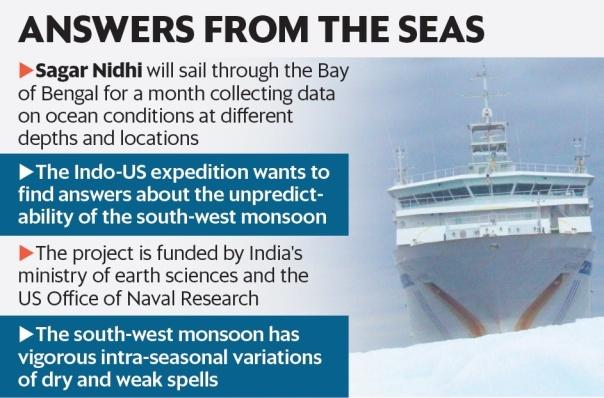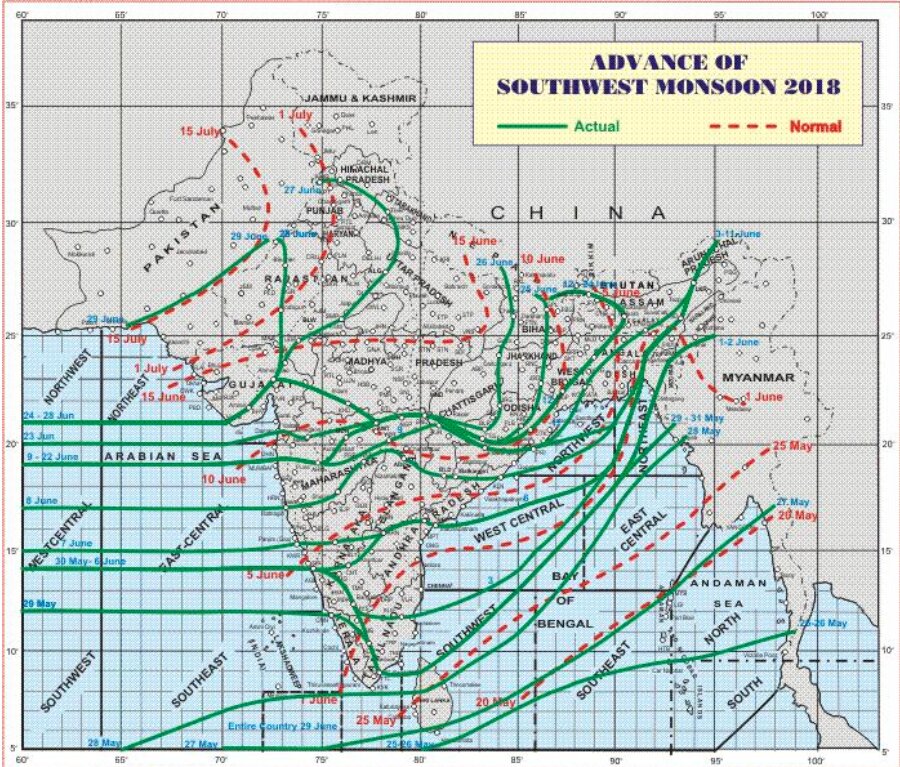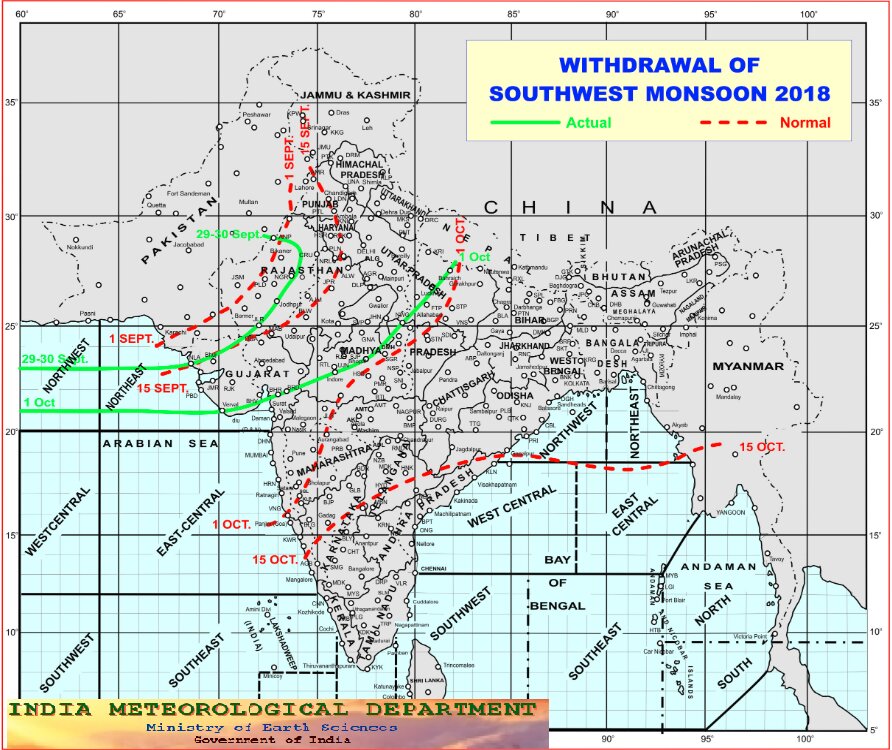Geography
Monsoon
- 24 Jun 2019
- 16 min read
Generally, across the world, the monsoons are experienced in the tropical area roughly between 20° N and 20° S.
The climate of India is described as the ‘monsoon’ type. In Asia, this type of climate is found mainly in the south and the southeast.
Out of a total of 4 seasonal divisions of India, monsoon occupy 2 divisions, namely.
- The southwest monsoon season - Rainfall received from the southwest monsoons is seasonal in character, which occurs between June and September.
- The retreating monsoon season - The months of October and November are known for retreating monsoons.
Factors Influencing South-West Monsoon Formation
- The differential heating and cooling of land and water creates a low pressure on the landmass of India while the seas around experience comparatively high pressure.
- The shift of the position of Inter Tropical Convergence Zone (ITCZ) in summer, over the Ganga plain (this is the equatorial trough normally positioned about 5°N of the equator. It is also known as the monsoon-trough during the monsoon season).
Inter Tropical Convergence Zone
The Inter Tropical Convergence Zone (ITCZ,) is a broad trough of low pressure in equatorial latitudes. This is where the northeast and the southeast trade winds converge. This convergence zone lies more or less parallel to the equator but moves north or south with the apparent movement of the sun.
- The presence of the high-pressure area, east of Madagascar, approximately at 20°S over the Indian Ocean. The intensity and position of this high-pressure area affect the Indian Monsoon.
- The Tibetan plateau gets intensely heated during summer, which results in strong vertical air currents and the formation of low pressure over the plateau at about 9 km above sea level.
- The movement of the westerly jet stream to the north of the Himalayas and the presence of the tropical easterly jet stream over the Indian peninsula during summer.
- Tropical Easterly Jet (African Easterly Jet).
- Southern Oscillation (SO): Normally when the tropical eastern south Pacific Ocean experiences high pressure, the tropical eastern Indian Ocean experiences low pressure. But in certain years, there is a reversal in the pressure conditions and the eastern Pacific has lower pressure in comparison to the eastern Indian Ocean. This periodic change in pressure conditions is known as the SO.
El Nino
This is a name given to the periodic development of a warm ocean current along the coast of Peru as a temporary replacement of the cold Peruvian current. ‘El Nino’ is a Spanish word meaning ‘the child’, and refers to the baby Christ, as this current starts flowing during Christmas. The presence of the El Nino leads to an increase in sea-surface temperatures and weakening of the trade winds in the region.
Mechanism
Onset of the South-West Monsoon
- The location of ITCZ shifts north and south of the equator with the apparent movement of the Sun.
- During the month of June, the sun shines vertically over the Tropic of Cancer and the ITCZ shifts northwards.
- The southeast trade winds of the southern hemisphere cross the equator and start blowing in southwest to northeast direction under the influence of Coriolis force.
- These winds collect moisture as they travel over the warm Indian Ocean.
- In the month of July, the ITCZ shifts to 20°-25° N latitude and is located in the Indo-Gangetic Plain and the south-west monsoons blow from the Arabian Sea and the Bay of Bengal. The ITCZ in this position is often called the Monsoon Trough.
- The shift in the position of the ITCZ is also related to the phenomenon of the withdrawal of the westerly jet stream from its position over the north Indian plain, south of the Himalayas.
- The easterly Jet Stream (Somali Jet) sets in along 15°N latitude only after the western jet stream has withdrawn itself from the region. This easterly jet stream is held responsible for the burst of the monsoon in India.
- As these winds approach the land, their southwesterly direction is modified by the relief and thermal low pressure over northwest India. The monsoon approaches the Indian landmass in two branches:
- The Arabian Sea branch - The monsoon winds originating over the Arabian Sea.
- The Bay of Bengal branch - The Arakan Hills along the coast of Myanmar deflect a big portion of this branch towards the Indian subcontinent. The monsoon, therefore, enters West Bengal and Bangladesh from south and southeast instead of from the south-westerly direction.
- Another phenomenon associated with the monsoon is its tendency to have ‘breaks’ in rainfall. The monsoon rains take place only for a few days at a time. They are interspersed with rainless intervals. These breaks in monsoon are related to the movement of the monsoon trough.
Despite an overall unity in the general pattern, there are perceptible regional variations in climatic conditions within the country.
Retreating Monsoon Season
- The retreating southwest monsoon season is marked by clear skies and rise in temperature.
- The land is still moist. Owing to the conditions of high temperature and humidity, the weather becomes rather oppressive. This is commonly known as the ‘October heat’.
- In the second half of October, the mercury begins to fall rapidly, particularly in northern India.
- The weather in the retreating monsoon is dry in north India but it is associated with rain in the eastern part of the Peninsula. Here, October and November are the rainiest months of the year.
- The widespread rain in this season is associated with the passage of cyclonic depressions which originate over the Andaman Sea and manage to cross the eastern coast of the southern Peninsula. These tropical cyclones are very destructive.
- A bulk of the rainfall of the Coromandel Coast is derived from these depressions and cyclones.
- Unlike the rest of the country, which receives rain in the southwest monsoon season between June and September, the northeast monsoon is crucial for farming and water security in the south.
Impact of Monsoons on Life in India
Positive
- About 64% of people in India depend on agriculture for their livelihood and agriculture itself is based on monsoon.
- Agricultural prosperity of India depends very much on timely and adequately distributed rainfall. If it fails, agriculture is adversely affected particularly in those regions where means of irrigation are not developed.
- Regional variations in monsoon climate help in growing various types of crops.
- Regional monsoon variation in India is reflected in the vast variety of food, clothes and house types.
- Monsoon rain helps recharge dams and reservoirs, which is further used for the generation of hydro-electric power.
- Winter rainfall by temperate cyclones in north India is highly beneficial for Rabi crops.
Negative
- Variability of rainfall brings droughts or floods every year in some parts of the country.
- Sudden monsoon burst creates a problem of soil erosion over large areas in India.
- In hilly areas sudden rainfall brings landslide which damages natural and physical infrastructure subsequently disrupting human life economically as well as socially.
Monsoon Prediction In India
- More than a century ago, when there were no computers, IMD’s forecasts depended only on snow cover. Lesser cover meant a better monsoon.
- British physicist Gilbert Walker, who headed the IMD, designed a statistical weather model – an empirical way of predicting the weather – based on the relationship between two weather phenomena.
- In 2014, the IMD started to use numerical models to supplement statistical models for long-range forecasting as well.
- Now, although the numerical models used by the IMD are state-of-the-art – developed by the US National Centres for Environmental Prediction – their forecast capacity is still weak because a longer period of forecast creates more uncertainty in prediction.
- At the moment, the IMD provides district-wise weather data but it’s not sufficient; because when IMD says there will be scattered rainfall over a particular district, it means that 26-50% that district (by area) will receive rainfall.
- The IMD collects weather data like temperature, humidity, wind and precipitation through 679 automatic weather stations, 550 surface observatories, 43 radiosonde or weather balloons, 24 radars and three satellites.
- Currently, highly advanced dynamical models need supercomputers. Prediction models will not run until proper data about current weather conditions is available.
Factors Responsible for Inaccurate Monsoon Forecast
- The lack of data due to insufficient monitoring stations.
- Automatic weather stations are of substandard quality. They need to be calibrated and cleaned regularly, which does not happen often. That affects data.
- Then, there are major data gaps, like those involving dust, aerosols, soil moisture and maritime conditions are not monitored.
- The models that we have brought from the west have been developed by western scientists to forecast in their region, little progress has been made is the fine-tuning of weather models to suit Indian conditions.
- Lack of competent software professionals and scientists working with the IMD.
Recent Indian Initiatives
It is crucial for farmers (sowing, harvesting, etc.) and policymakers (payment of compensation, minimum support price, etc.) to know when and for how long the monsoon will remain active over India. For that, better predictions and timely advisories are needed.
To achieve this following initiatives have been taken:
- Monsoon Mission of India
This initiative of Ministry of Earth Sciences, launched in 2012, has utilized new approaches (high resolution, super parameterizations, data assimilation etc.) so that forecast skill gets quantitatively improved further for forecasting services of India Meteorological Department (IMD).
For the first time, India Meteorological Department used the Monsoon Mission dynamical model to prepare operational seasonal forecast of 2017 monsoon rainfall over India.
Objectives- To improve Seasonal and Intra-seasonal Monsoon Forecast
- To improve Medium Range Forecast.
- IMD in collaboration with Indian Council of Agricultural Research (ICAR) provides district-level agro-meteorological advisories to farmers through 130 agro-met field units in vernacular languages.
These advisories are used for critical farm operations such as:- Management of sowing (delayed onset of rains);
- Changing crop variety (delay in rainfall);
- Spraying Pesticides for disease control (occurrence of rainfall);
- Managing Irrigation (Heavy rainfall Forecast).
- India Meteorological Department (IMD) provides meteorological support to the Central Water Commission (CWC) for issuing flood warnings.
- Indo-US expedition

In 2018, The Indian Ocean Research Vessel, 'Sagar Nidhi', set out from Chennai, as part of an Indo-US expedition seeking to find answers to the vagaries of the Bay of Bengal-fed southwest monsoon by collecting various data to improve prediction models. - National Supercomputing Mission will fill the necessary gaps in the computing superpower required to predict timely and accurate monsoon forecasts.
Global Warming and Monsoon
- A drastic change in the monsoon rainfall intensity, duration, frequency and spatial distribution can be attributed to the climate change. However, it is too soon to arrive at a conclusion.
- If all this is in response to global warming then it can be permanent and might accelerate. If not then the monsoon system will revert to a more normal state.
- More data and reanalysis is needed to get a clear picture on the complete separation of the global warming impact from natural climate variability (such as El Niño).
Way Forward
- The population of India is increasing and to provide food security to the population, a large part of the monsoon water which is currently unutilized should be held at suitable locations for irrigation and power generation purposes.
- India needs to invest more resources in better prediction of Monsoon forecast in order to achieve reliability and sustainability.
- With a warming climate, more moisture will be held in the atmosphere, leading to heavier rainfall, consequently, inter-annual variability of the monsoon will increase in future. The country needs to prepare for this change.
- Thus, to secure and bring sustainability to the climate pattern of India we need to take effective and timely steps not just at the domestic front (National Action Plan on Climate Change) but also at international front (UN Framework Convention on Climate Change), as we live in a shared world with a shared future.








